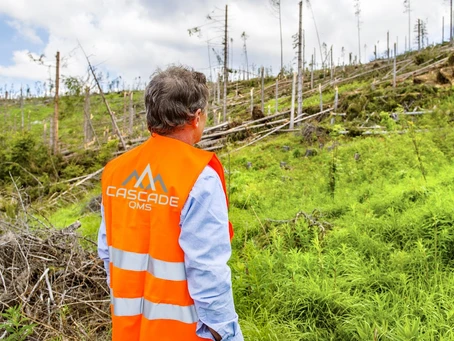Heightened Risks of Severe Weather
The threat of severe weather can vary depending on the region and weather patterns, but generally, the threat of severe weather is heightened during certain seasons.
In the United States, for example, the spring season (March to June) is known for being a peak time for severe weather, particularly in the central and southern regions of the country. This is when warm, moist air from the Gulf of Mexico collides with cold air from the north, creating a volatile mix that can lead to tornadoes, thunderstorms, hail, and flash floods.
Similarly, in some parts of the world, such as Southeast Asia and the Indian subcontinent, the monsoon season (usually from June to September) can bring heavy rains, flooding, and landslides. However, it’s important to note that severe weather can occur at any time of the year and in any location, so it’s always a good idea to stay informed about weather conditions and be prepared for emergencies.
Associated Threats
Working during severe weather on construction job sites can pose many threats to workers. Some of the most common threats include:
- Lightning strikes: Thunderstorms can produce lightning, striking metal objects such as cranes, scaffolding, and other equipment on construction sites. Workers who are exposed to these objects are at risk of being struck by lightning.
- High winds: Strong winds can knock down scaffolding, topple cranes, and cause other objects to become airborne, putting workers at risk of injury or death.
- Heavy rain and flooding: Heavy rainfall can cause flooding, making working conditions dangerous and leading to slip-and-fall accidents. Floodwaters can also damage equipment and structures.
- Extreme temperatures: Working in extreme heat or cold can put workers at risk of heat exhaustion, heat stroke, or hypothermia, which can be life-threatening.
- Tornadoes and hurricanes: In regions prone to tornadoes and hurricanes, construction workers are at risk of being directly in the path of these storms, which can cause significant damage and result in injury or death.
To mitigate these risks, construction companies should have safety protocols in place for severe weather conditions, such as having designated shelter areas, monitoring weather alerts, and suspending work if conditions become too dangerous. Workers must be trained on how to respond to severe weather and equipped with appropriate personal protective equipment (PPE). Examples are: hard hats, safety glasses, and work boots.
Employee Training
Properly preparing employees for severe weather risks involves six steps:
-
Develop an Emergency Response Plan: Employers should develop a written emergency response plan that includes procedures for severe weather events. This plan should be communicated to all employees and reviewed periodically to ensure that it is up-to-date.
-
Educate Employees: Employers should educate employees on the types of severe weather typical in their region, the risks associated with extreme weather, and the steps employees should take to protect themselves during a severe weather event. This education can be provided through training sessions, posters, emails, or other communication channels and utilization of the National Weather Service.
-
Establish a Communication Plan: Employers should establish a communication plan with emergency contact information and procedures for reporting severe weather events. This plan should also include a system for notifying employees of severe weather warnings or alerts.
-
Provide Personal Protective Equipment (PPE): Employers should provide appropriate PPE to employees to protect them from the risks associated with severe weather, such as hard hats, safety glasses, work boots, and rain gear.
-
Conduct Drills and Exercises: Employers should conduct drills and exercises to prepare employees for severe weather events. These drills should include practice evacuations, sheltering-in-place procedures, and other emergency response actions.
-
Monitor Weather Conditions: Employers should monitor weather conditions and alerts using reliable sources, such as the National Weather Service, and take appropriate actions based on the severity of the weather conditions.
Overall, properly preparing employees for severe weather risks involves a combination of education, communication, planning, and practice. By taking these steps, employers can help to protect their employees from the risks associated with severe weather events.
Severe Weather Toolbox Talk
A severe weather toolbox talk is a safety meeting that prepares workers for potential extreme weather events on a construction site or in a workplace. An informal safety meeting provides workers with important information and reminders about staying safe during severe weather conditions.
During this meeting the safety coordinator or supervisor will typically review the emergency response plan. Additionally, they will explain the extreme weather typical in the area, and provide instructions on responding to warnings or alerts. The safety coordinator may also provide information about the hazards that severe weather can create on the worksite. Hazards include the risk of lightning strikes, wind damage, or flooding.
Additionally, covered during a severe weather toolbox talk are the importance of personal protective equipment (PPE), such as hard hats, safety glasses, and work boots. The importance of seeking shelter and avoiding exposure to the elements during severe weather events is also discussed. The toolbox talk may also include reviewing emergency procedures, such as the evacuation plan and strategies for sheltering in place.
Preparing with Toolbox Talks
By conducting regular severe weather toolbox talks, employers ensure workers are prepared and equipped to respond safely to extreme weather events. More so, these training reinforce a safety culture on the job site and demonstrate the employer’s commitment to worker safety.
Cascade QMS has various Toolbox Talks developed to assist your company with preparedness for all risks. Consider a Severe Weather Safety Program for more in-depth training. Cascade QMS also has a Safety Program to assist employee education and preparedness. Reach out today for your complimentary Severe Weather Toolbox Talk!


